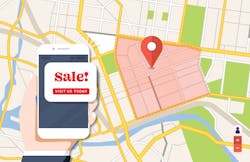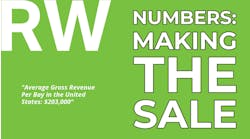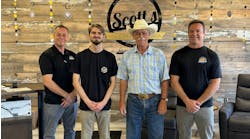SHOP STATS: TGK Automotive Location: 19 Locations in Minnesota Operator: Troy Kaplan Average Monthly Car Count: 500 Staff Size: 155 Average Shop Size: 7,000 square feet Annual Revenue: $36 million
In an age dominated by digital marketing, there are plenty of ways to capture the attention of your next potential lifelong customer, but a new marketing tactic is helping shops take a much more targeted approach.
Gaining popularity among automotive businesses for its ability to pinpoint specific audiences, shops are embracing the tool to zero in on customers who would likely be interested in an auto repair shop in the geographic locations they’re likely to be in.
According to the Pew Research center, nearly 90 percent of Americans keep location services on their phone, and geofencing uses these services to target ads to people in a specific area. The tool allows you to target a large area or specific businesses, then send your ads to the people that enter those locations, who are likely to continue seeing your ads for several days, even after they have exited the “geofenced” area. Geofencing campaigns can analyze how many people walk into your flagged locations, how many click on your ad, and how many customers those ads brought to your business.
Troy Kaplan, owner of 19 TGK Automotive locations based in Minneapolis, Minn., has used the marketing technique with great success, noting that his campaigns bring in at least 55 new customers each month with geofencing alone.
For more insight on what makes a successful geofencing campaign as shop owners get started with the tool, Ratchet+Wrench checked in with Kapland and marketing pro Megan Williams, cofounder and digital strategist for Indiana-based 3P Marketing Solutions.
Choose your partner wisely.
You won’t be able to carry out a geofencing campaign all on your own. You’ll want the help of a marketing firm that specifically services auto repair shops to ensure your partners will know the ins and outs of your business.
“You’re looking for someone that understands who you need to be targeting so they can set your campaign up to perform at its best,” Williams says.
Not every marketing company that offers geofencing is cut from the same cloth. Some will work with you hand-in-hand while others will execute your campaign and deliver analytics but communicate little else. An ideal marketing partner will manage each step of your campaign, from the ad design to the analytics.
“We tried geofencing before with some bigger companies in the industry and it didn’t work because they just set it up and left it,” Kaplan says. “There was no oversight.”
Be as specific as possible.
Broad, general, and sweeping demographic targets may work well with some marketing tactics, but aren’t necessarily your best bet when it comes to geofencing.
Geofenced campaigns can be used to blanket large areas or neighborhoods, including highways, and schools, but they may not reach a high volume of customers looking for auto repair. You may reel in a few, but a blanket approach will likely be a waste of an ad.
“The more direct you can be, the better,” Williams says.
Kaplan first tried geofencing three years ago, when blanketing an entire area was the norm. He found much better success with a switch to a new, local marketing firm that was able to target specific locations and businesses in the area.
“We focused on local businesses that have high traffic in our area instead of blanketing a freeway, we went after a specific, physical address, and we got much better results,” Kaplan says.
Williams suggests choosing specific locations and businesses that likely attract the same customers that would go to your shop. This could include dealerships, auto body or collision repair shops, or even another local competitor.
Keep track of your data.
One of the perks of a purely digital campaign? You’re left with plenty of data to track to analyze and gain an understanding of what performed best.
In tracking how many ads are being sent out each month and what percentage of those ads are getting clicked on, Williams says you’ll want to measure the number of new customers who come to you specifically because of a geofencing ad as well as the locations on your geofencing map that carry the most traffic.
“That reporting is what really sets digital marketing apart from every other type,” Williams says. “That monthly reporting is literally telling us how many people saw the ad, clicked on the ad, and then came into your center afterwards.”
Stay conscious of clickbait.
It’s not exactly a trade secret that some of the most successful ads are designed to draw consumers in with visual appeal, but it’s an important universal trend to keep in mind when finalizing a geofencing campaign.
Your campaign’s best results may rely on drawing in customers with clicker-happy ads, Williams says, so it’s important to track any increases in traffic to your website and the number of times people clicked on your ads. A lack of traffic boosts could be a sign your ads aren’t visually appealing enough to entice consumers to click through and that it may be time for a change.
Be prepared for new business.
From global corporations to small mom and pop shops, anyone can benefit from a geofencing campaign. However, it’s worthwhile to avoid committing to a geofencing campaign until you’re ready to grow or looking to expand.
“Geofencing is a great fit for a shop of any size, the one thing that you need, though, is to be willing and able to grow, because it’s going to be bringing you more business,” Williams says.
If your shop is already operating at capacity and your team is slammed or understaffed, it may be best to hold off until you’re best positioned to service those new clients. Same goes if you’re planning to make new hires or adopt a new shop system.
Kaplan only employed a geofencing marketing team when he was ready to start opening new TGK Automotive locations.
“We looked into doing it when we started expanding in the Twin Cities. With more locations, we were trying to get in front of more people and fresh eyes,” Kaplan says. “We were ready for that traffic as a part of that next step.”



